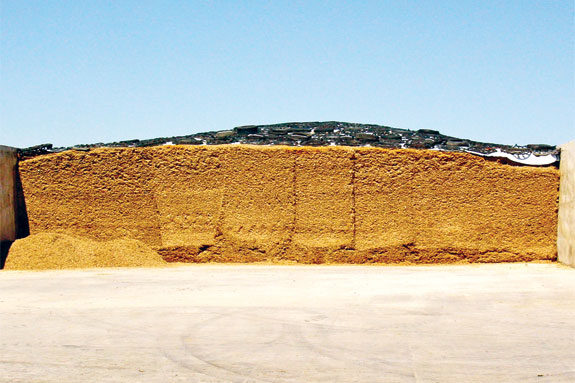From 2007 to 2011, an average of 108.5 million tons of whole-plant corn was harvested annually for silage in the U.S. The majority of corn silage was stored in large bunker silos and drive-over piles. But filling bunkers and piles can pose serious risk to you and your employees – especially those who operate the pack tractors.
It’s important as a dairy owner that you implement safety guidelines well in advance of harvest. Here is a look at steps you should consider.
1. Properly equip tractors to prevent tractor rollovers
• Equip tractors with rollover protective structures (ROPS) and seat belts. When used with a seat belt, ROPS prevents the tractor operator from being thrown from the protective zone and crushed by the tractor or other equipment.
• Use low-clearance, wide front-end tractors equipped with well-lugged tires to maintain traction.
• Add weights to the front and back of tractors to improve stability.
2. Prepare safety measures for bunker silos
• Mount sight rails on above-ground bunker walls. These rails indicate the location of the wall to the tractor operator but are not intended to hold an overturning tractor.
• If filling will occur at night, install lights to the rail.
Large rectangular or round hay and straw bales should never be used for temporary bunker walls.
3. Ensure proper packing procedures
• Have a “silage team” meeting to discuss the packing procedure before harvest begins. Discuss everyone’s role in the silage packing process, including how to stay safe.
If you work with a silage contractor, the contractor and his or her pack tractor operators should also attend this meeting.
• Only mature, experienced employees should operate pack tractors.
• Explain to employees how to form a progressive wedge of forage and maintain a minimum slope of 1-to-3 (one foot of rise per three feet of horizontal).
The slope can be decreased to 1-to-4 or 1-to-5, depending on the rate of forage delivered to the bunker or pile.
• Tractors should be backed up, not driven forward, on any steep slopes to prevent rollbacks.
• Do not allow ruts to develop, which could cause the tractor to roll over.
• When using front-end loaders to move forage to the bunker or pile, do not carry the bucket any higher than necessary to help keep the center of gravity low.
• When two or more pack tractors are used, establish a driving procedure to prevent collisions.
• Bunker silos should never be filled higher than the top of the wall.
• Never allow people on foot (especially children) in or near a bunker or pile during filling.
Maintain a proper shape of drive-over piles
• Shape drive-over piles using a minimum slope of 1-to-3 on the back and each side.
• Piles should be packed from side-to-side as the progressive wedge advances.
Too often producers disregard these rules for piles because they are trying to put too much silage into too small of a space.
As a result silage piles have side slopes of 1-to-1 or less and tower 20 to 25 feet or more above the surface.
In addition to greatly increasing the risk of a tractor rollover accident, there is no way the tractor operator can pack the sides to an acceptable silage density.
Lower silage densities mean higher shrink losses. About 20 percent of corn silage harvested each year is lost to shrink. This loss comes at a cost of more than $1.3 billion.
4. Bottom line
Tractor rollover accidents account for about 50 percent of the tractor-related fatalities reported annually. Think safety first – packing accidents in bunker silos and drive-over piles can be prevented if these safety guidelines are put in place. PD
Keith Bolsen is professor emeritus at Kansas State University. Ruth E. Bolsen is the managing director of Keith Bolsen & Associates.
See the August issue of El Lechero for more materials to help owners teach employees about silage packing safety.

Keith Bolsen
Professor Emeritus
Kansas State University









